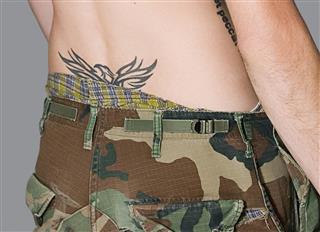
“Because I’m exploring my gender identity, the bimbo aesthetic allows me to feminise my masculinity. “It’s this part-parody, part-transformation of these derided fashion trends and gender expressions,” Takar says. They see the tattoo’s resurgence as part of a broader celebration of “bimbo” culture among queer people. “Especially in the late 1800s and early 1900s, it was an excuse to put pictures of women wearing fewer clothes in the newspaper than you’d normally be able to.”Īdam Takar, a 24-year-old training tattoo artist in Berlin, is conjuring up an “abstract, cyborg-looking design” for their tramp stamp. “Women getting tattooed has been a fascination of the tabloid media for a long time,” Lodder explains. He points to a tabloid article from 1950 about young women getting spider tattoos on their backs as good luck charms: “What will women think of next?” reads the outraged opening line.

While these sentiments encapsulate the lower back tat’s taboo status by the end of the 2000s, tattoo historian Matt Lodder says this kind of coverage is nothing new. Whatever will they bring out next? Drug-addict Barbie? Alcoholic Barbie?” One reader weighed in: “Barbie should be at the high end of fashion, not the chav end. Never one to miss an opportunity for body-shaming, even in the case of a plastic toy, The Daily Mail ran a feature on it, expressing their horror at this disruptive addition to Barbie’s “blonde locks, slender legs and sweet smile” and their fear that it could “further encourage the sexualisation of young girls”. In 2009, to celebrate her 50th birthday, Barbie was given a tramp stamp as part of Mattel’s “Totally Tattoos” range. Among them was Los Angeles artist Jill Jordan, a former fashion designer, who called the lower back tattoo “the chick spot” and described it as “a tremendously sexy and really flattering way to be tattooed: it just narrows your waist.” By the turn of the millennium, Mifflin continues, “this had become such a clichéd location for women’s tattoos, displayed popping out of low-slung hip-huggers, that it was known as the ‘tramp stamp’. As Margot Mifflin writes in Bodies of Subversion (2013), “women artists brought a new sensitivity to tattoo placement” during the late 1980s and 1990s. The tramp stamp wasn’t always the tramp stamp, though.

Much like the celebrities who wore them, tramp stamps were excessively sexualised by the media and then their owners were shamed because of them. But, as their derogative nickname confirms, even in their heyday they were the target of sexist ridicule. And one Y2K aesthetic suffered more than any other: the lower-back tattoo aka the so-called ‘tramp stamp’.įrom Britney’s fairy to Brandy Norwood’s flower, Christina Aguilera’s romantic quote to Drew Barrymore’s angels, Nicole Richie’s cross to Jessica Alba’s bow, these cute bits of body art peeked out from backless dresses and Juicy Couture sweatpants, earning their place in the noughties hall of fame. Body-judging, slut-shaming and impossible double standards were rife, all perpetuated by the tabloid press. Through rhinestones, velour and distressed denim, fashion became supercharged with a clashy, trashy glamour that feels fun, flirty and free.īut amidst all the rose-tinted romanticisation of Y2K culture, it is all too easy to gloss over the time’s rampant misogyny, as pervasive as the flip phone.

Ushered in by a desire for a sparklier, more hedonistic time, this wave of nostalgia brought back all the trademarks of feminine late 1990s and early 2000s style: low-rise jeans, tiny handbags, baby tees, butterfly clips, acrylic nails, and embellished belts chunkier than the mini skirts they hold in place. As the 2020s dawned, the Y2K Renaissance began.


 0 kommentar(er)
0 kommentar(er)
